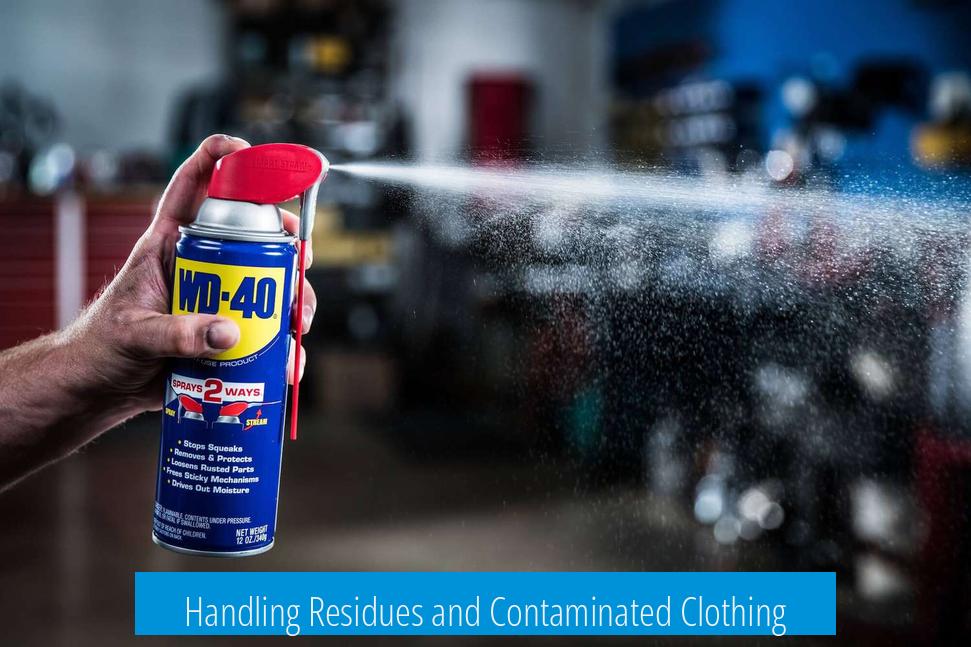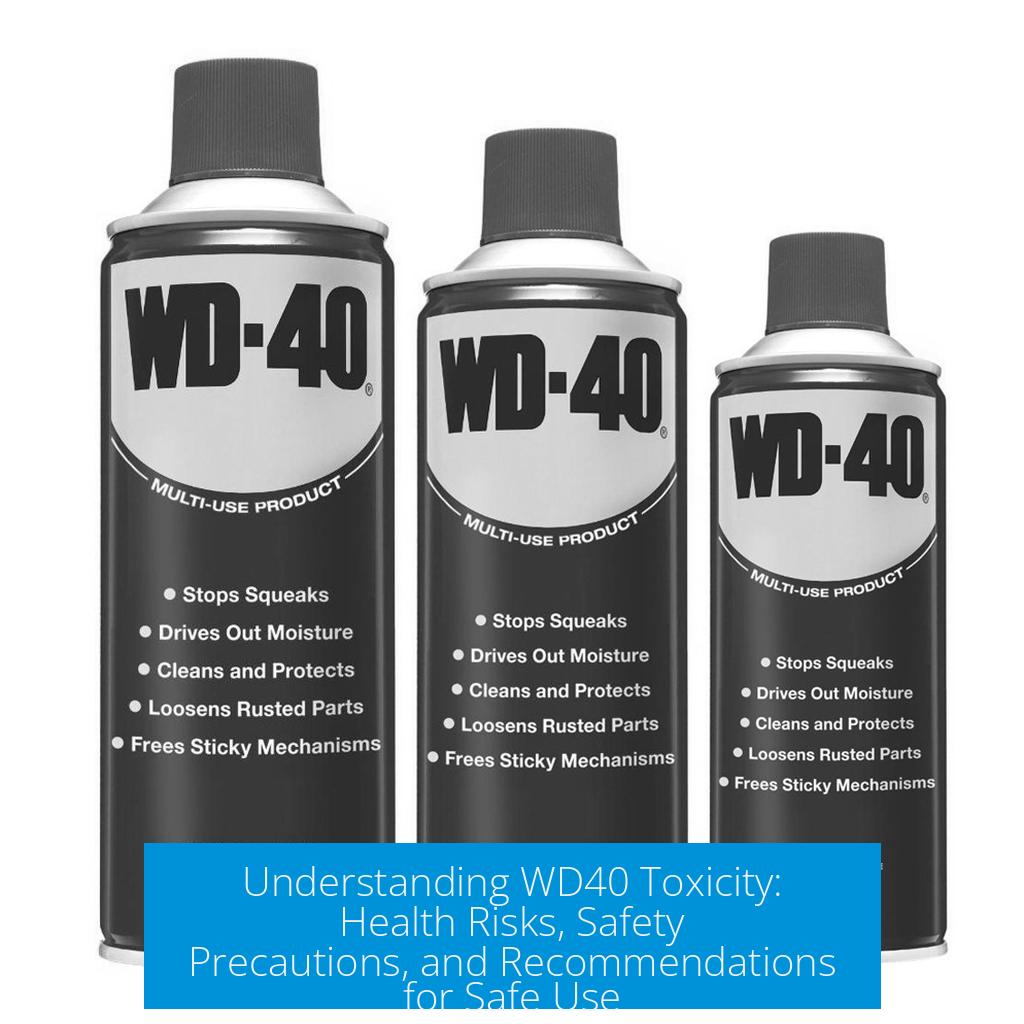WD40 toxicity is generally low when used as intended, but it poses risks through ingestion, prolonged inhalation, and skin exposure. Proper ventilation, hygiene, and handling precautions significantly reduce these risks.
Chemical Composition and Toxicity

WD40 consists mainly of hydrocarbons such as nonane, decane, and dodecane. It may also contain xylene and similar solvents. These compounds exhibit toxicity primarily through prolonged inhalation. However, given their volatile nature, they tend to evaporate within one to two hours under well-ventilated conditions.
The product’s hydrocarbon mixture allows it to act as a cleaning and penetrating agent but increases risks if used in confined spaces without airflow. Inhalation of fumes over extended periods can cause symptoms such as dizziness and lightheadedness.
Super Penetrants in WD40
WD40 may include components resembling dimethyl sulfoxide (DMSO), known as “super penetrants.” These solvents facilitate the transport of chemicals across cell membranes. This means substances on the skin can enter the bloodstream more easily if not washed away promptly.
The presence of such carriers underscores why washing hands before and after use is critical. Avoiding prolonged skin contact minimizes internal exposure to harmful chemicals.
Exposure Routes and Symptoms
- Ingestion: Harmful and potentially toxic; ingestion should be avoided entirely.
- Inhalation: Short-term exposure to fumes in ventilated areas is unlikely to cause serious harm. Prolonged exposure may trigger dizziness and nausea.
- Skin Contact: Can lead to irritation and enhanced chemical absorption due to penetrant solvents like DMSO.
- Eye Contact: Possible irritation if splashed or misted; eye protection is advisable in high-risk situations.
Safety Precautions
WD40 use requires several simple but effective safety measures:
- Wear gloves to prevent skin contact.
- Use eye protection if splashing is probable.
- Operate only in well-ventilated areas.
- Avoid inhaling fumes directly.
- After use, allow ventilation of any enclosed space for 4 to 24 hours.
- Wash skin immediately after handling to remove residues.
- Do not expose contaminated clothing to heat or machine drying; fire hazard risk exists.
Handling Residues and Contaminated Clothing

WD40 leaves residues from low volatility hydrocarbons after rapid evaporation of lighter components. While residues are not highly hazardous, they can accumulate on surfaces, potentially causing damage or contamination.
Clothing soaked with WD40 poses fire risks if exposed to laundering machines due to residual hydrocarbons. Such clothing should be handled carefully, dried away from ignition sources, or disposed of properly to avoid accidents.
WD40 as a Lubricant and Solvent
Contrary to popular belief, WD40 is not primarily a lubricant. It dissolves viscous organic compounds such as grease and oxidized fats, temporarily freeing stuck mechanisms. This action reduces friction initially but does not replace true lubricants for long-term maintenance.
Its solvency makes it effective for cleaning tasks, such as removing marks from whiteboards, where it performs similarly to white spirit, a less toxic solvent. However, WD40 contains some hazardous solvents not found in simpler alternatives.
Health Impact Summary
WD40’s toxicity profile under typical conditions is low. Mild effects arise mainly from ingestion or extensive inhalation without ventilation. Skin absorption is a potential risk due to carrier solvents, emphasizing hygiene after contact.
Users report a noticeable odor on spraying, which dissipates quickly with ventilation. Comparing it to gasoline, WD40 appears less concerning under similar exposure due to its lower volatility and toxicity.
Summary Table of WD40 Toxicity and Safety
| Exposure Type | Potential Effect | Recommended Actions |
|---|---|---|
| Ingestion | Harmful; toxic | Avoid ingestion at all costs; seek medical help if ingested |
| Inhalation (Short-term, Ventilated) | Minimal; possible mild dizziness | Use in well-ventilated areas; avoid prolonged exposure |
| Inhalation (Prolonged, Enclosed) | Dizziness, lightheadedness | Evacuate area; ventilate for 4-24 hours |
| Skin Contact | Irritation; enhanced chemical absorption | Wear gloves; wash skin promptly after exposure |
| Eye Contact | Irritation | Wear goggles if risk present; rinse eyes if contact occurs |
| Residue on Clothes | Fire hazard during laundering | Handle contaminated garments carefully; avoid machine drying |
Practical Recommendations for Safe Use
- Always use WD40 in spaces with good airflow to allow fumes to disperse quickly.
- Wear nitrile or latex gloves when applying WD40 to prevent skin absorption of solvents and hydrocarbons.
- Use eye protection when spraying overhead or where mist is possible.
- After application, ventilate the space for several hours to clear airborne compounds.
- Wash hands and any exposed skin immediately after use.
- Store WD40 away from heat sources and flames due to its flammability.
- Dispose of contaminated rags or clothing carefully to prevent fire risks.
Conclusion
WD40 contains hydrocarbons and solvents that carry some toxicity risk primarily via ingestion, prolonged inhalation, and skin absorption. It is not highly toxic under normal, cautious use. Key safety measures such as ventilation, skin and eye protection, and hygiene minimize potential harm.
Residues remaining after evaporation are not a significant health risk but require care to avoid surface or clothing damage. The flammability hazard posed by vapors and contaminated textiles requires attentiveness.
Compared to harsher solvents and fuels, WD40 toxicity is moderate. Correct application aligns with occupational safety practices and prevents adverse health effects.
Key Takeaways
- WD40 is not highly toxic but harmful if ingested or inhaled extensively.
- Hydrocarbon fumes cause dizziness with prolonged exposure, avoid enclosed spaces.
- Skin absorption can increase risks due to super penetrant solvents; wash immediately after contact.
- Use gloves and eye protection during application.
- Ventilate well during and after use; residues can persist but pose low direct hazard.
- Flammable vapors and contaminated clothing present fire hazards; handle and dispose safely.
- WD40 acts as a solvent to loosen parts but lacks long-term lubrication properties.
Is WD40 toxic if inhaled for a short period?
Short-term inhalation of WD40 fumes usually causes no harm. Symptoms like dizziness or lightheadedness may appear if exposure is prolonged. Use in well-ventilated areas to avoid these effects.
Can WD40 penetrate the skin and cause systemic effects?
WD40 may contain solvents like DMSO that carry chemicals through the skin. This can increase absorption of harmful substances. Wash skin immediately before and after contact.
Does WD40 leave harmful residues after use?
WD40 has low-volatility components that leave residues. These are not typically dangerous but may affect surfaces. Proper ventilation helps evaporate volatile parts within a few hours.
What precautions should I take with clothing contaminated by WD40?
Contaminated clothing can pose a fire risk if washed or dried in machines. Avoid prolonged skin contact and handle soiled clothes carefully to prevent accidents.
Is it safe to use WD40 indoors without ventilation?
No. Using WD40 in enclosed spaces without ventilation may cause accumulation of toxic fumes. Always ventilate for 4 to 24 hours after use and consider evacuating the area.





Leave a Comment